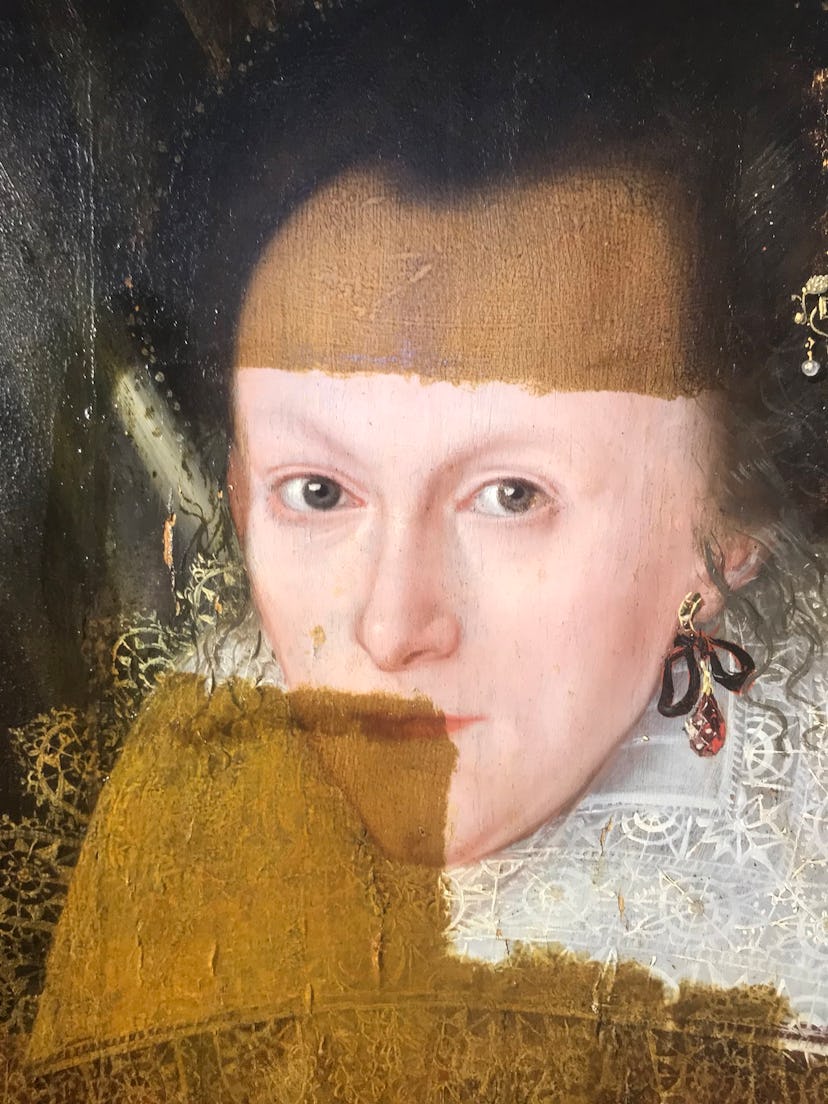A 400-Year-Old Painting is Restored Almost Instantly in Oddly Satisfying Video

Thanks to British art dealer and historian Philip Mould and a painting known unofficially as The Lady in Red that dates basks to 1618, we have found our new weird internet obsession: videos of antique paintings being restored to their near-original luster.
See, the internet is full of transfixing genres of videos that people have dubbed “oddly satisfying.” Some like watching kinetic sand being cut with a knife. Others are into people smashing their faces into loafs of bread. Our good friends over at Allure are really into videos of pimple popping and other cosmetic medical oddities. We’re really into ASMR (we’ve gotten Cara Delevingne, Margot Robbie and Eva Longoria to do it), but right now, the only thing we care about are these videos of Mould instantly removing hundreds of years of grime for this painting.
When Mould first got a hold of the painting, its varnish had notably yellowed with age. According to Mould, its last coat of protective varnish had been applied about 200 years ago. Sure, the sepia-tint may resemble Melania Trump’s favorite Instagram filter, but it’s not very chic, nor does it represent the original painting that well.
A few days ago, Mould started posting videos of the cleaning process on his Instagram. It is transfixing. Pay attention to the colors and details the had been lost over the years as they suddenly reemerge.
Here’s part two:
A close look at some of the details that has been recovered:
So, what’s going on here, exactly? Well, the internet is sort of divided.
Varnish is often applied to oil paintings as a protective layer from dust, smoke, and other potential pollutants and ruiners according to Will Kemp’s website. Instead of the actual paint, the varnish collects the dirt and damage, and that’s part of the reason it yellows over time. The good news is that the varnish can be removed and replaced, and usually is at least once every century. Think of it as a semi-permanent slip cover for your art collection and not your sofa (or Calvin Klein coat). Though, the removal process isn’t usually quite this dramatic or quick. Gizmodo points out that they’re not quite familiar with the technique or solvent Mould is using, though he tells The Telegraph that he’s using a gel solvent that has been developed in the past few years.
The entire process won’t be quite as quick and easy as the video makes it seem, either. It will take up to three weeks for the entire painting to be cleaned.
Mould also hopes to figure out the exact provenance of the painting. It was bought recently from a private collection, and the only detail that is known other than the date is that the woman in the picture was 36 at the time she sat for the portrait. He hopes to uncover clues leading to the identity of both the subject and the painter.
Though, at the moment, we just want to identify clues that will lead us `to more videos of amazing art restorations. Unfortunately, there’s not that many uncleaned 400-year-old paintings sitting around and Mould’s exact process is apparently relatively new.
Luckily, YouTube does give us at least one time lapse videos of varnish removal to fill our apparently new addiction. Here’s Jacopo Zucchi’s “Portrait of a Lady” being stripped of it’s varnish.
That’ll have to do for the moment. Hopefully Mould gets his hands on some other yellowing art mysteries soon.
Related: Here’s What Food Tutorials Directed by Wes Anderson, Quentin Tarantino and More Would Look Like
Chameleons of the Art World: The Humans of Frieze New York: